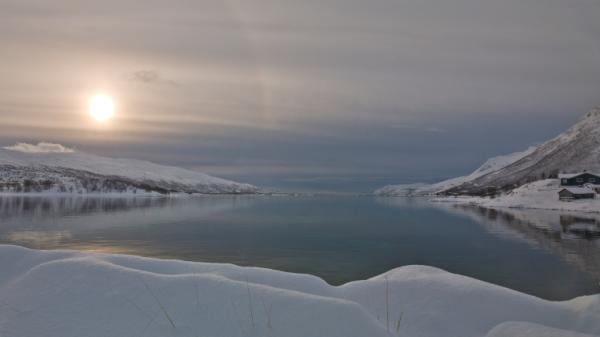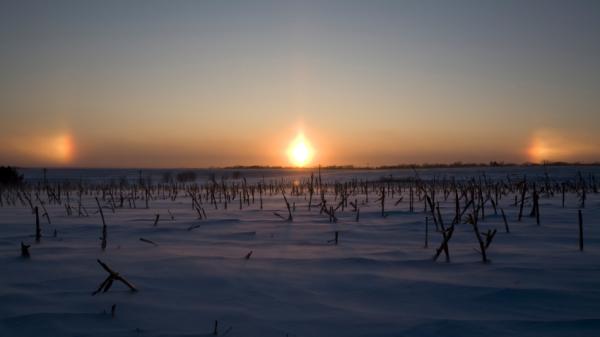Halos, Sundogs, and Light Pillars
Sundogs, light pillars, and other kinds of halos seen in the sky are atmospheric phenomena that occur when light is reflected or refracted by ice crystals in the atmosphere.

A Sun halo seen from Lofoten Islands, Norway.
©iStockphoto.com/antony spencer
The size, shape, and distance from the Earth’s surface of the ice crystals determine what kind of optical phenomenon people on Earth will observe. It also depends on whether the light is reflected or refracted by the ice crystals.
Reflection occurs when light bounces off the surface of an object. On the other hand, refraction occurs when light enters an object and bends.
Astronomical terms & definitions
Ice Crystals
Ice crystals can be found high up in the sky all around the world, at any time of the year. Generally, these crystals, which have a hexagonal molecular structure, are found in the cirrus clouds. Sometimes, in very cold weather, ice crystals form very close to the Earth’s surface. These crystals are known as diamond dust.
While the molecular structure of ice crystals is always hexagonal, their shape can vary from a flat plate to a column. Halos and other optical phenomena are created because of the interplay between the shape of the ice crystals and the angle between their facets. This angle is always 60 or 90 degrees. Because of this, scientists who study atmospheric optical phenomena classify them as 60-degree or 90-degree phenomena.
In addition to the shape of the ice crystals and the angle between the facets, the orientation of the ice crystals also determines the kind of optical phenomenon that will be created. Plate-shaped crystals float in the air horizontally like a leaf. On the other hand, column-shaped ice crystals tend to float in the air vertically.
The Different Kinds of Atmospheric Phenomena
Halos
Two kinds of halos are most commonly observed from Earth – the 22-degree and the 46-degree halos. In general, halos can be seen throughout the year, around the world. However, they are more often seen in the winter months because the cold weather creates better conditions for the formation of halo-generating ice crystals.
22-degree halos are formed when light passing through an ice crystal bends 22 degrees, while 46-degree halos occur when the light bends 46 degrees.

Ice crystals in the atmosphere create glowing spots on both sides of the Sun, called sundogs.
©iStockphoto.com/ Scene_It
Sundogs
A sundog, also known as sun dog, mock sun or parhelion, consists of glowing spots around the sun. They are created by sunlight refracting off plate-shaped ice crystals in the cirrus clouds. Sundogs are some of the most frequently observed optical phenomena and can be observed throughout the year and anywhere in the world. They are also associated with 22-degree halos.
Sundogs tend to be most visible when the Sun is close to the horizon. The part of a sundog closest to the Sun tends to be red in color, while the areas further away from the Sun generally appear blue or green.
Light from the Moon also creates glowing spots on both sides of the Moon, called moondogs. Also known as mock moon or paraselene, moondogs are rarer than sundogs because they only occur when the Moon is full or close to being full.
Is the Moon upside-down in the other hemisphere?
Light Pillars
Generally seen in cold, arctic regions, light pillars are an optical phenomenon where columns of light can be seen emanating from below or above a light source. Light pillars occur when natural or artificial light reflects off flat ice crystals in the air close to the Earth’s surface.
Light pillars caused by the Sun are called Solar or Sun pillars, while those caused by the Moon’s light are called Lunar or Moon pillars. When the light source is the Sun, light pillars are usually seen when the Sun is near the horizon. While Sun and Moon pillars are more common, light pillars can also occur due to the presence of artificial lights.
Because the ice crystals in the atmosphere reflect the source light, light pillars tend to take on the color of the light source.
Parhelic Circle
Parhelic circles are a rarer optical atmospheric phenomenon. They are white circular bands in the sky at the same level as the Sun or Moon. Generally, only parts of the circle can be seen at a time. They are generated when vertical or nearly vertical ice crystals of any shape reflect sunlight (or moonlight).
Observing Sun Dogs and Halos
Always take precautions while observing any Sun related phenomena. Never look directly into the Sun. Always wear protective glasses or use objects to block the direct glare of the Sun.